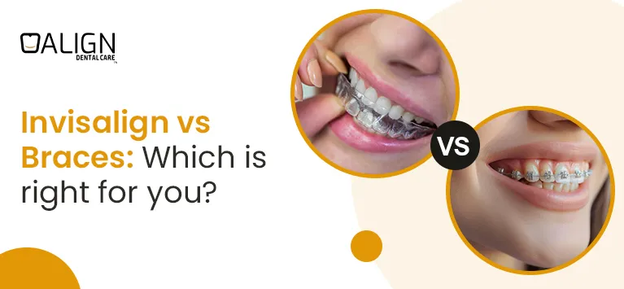
Orthodontic treatment is necessary to preserve your overall oral health in addition to improving your appearance. Selecting between Invisalign and braces for a straighter smile may be challenging. While each has benefits, which is the best option for you? It all boils down to personal preference, price, time, and upkeep. In order to help you make an informed decision, let's look at the details together.
Invisalign
-
With the inconspicuous Invisalign treatment, teeth are gradually realigned using clear aligners.
-
Overcrowding, irregular spacing, and biting issues are just a few of the malocclusions that Invisalign is quite successful in treating.
-
However, extreme occurrences of misalignment may require the use of alternative orthodontic procedures and reduce the effectiveness of Invisalign.
Braces
-
Braces use wires and brackets to apply pressure to teeth to shift them into the desired positions.
-
Braces are well known for their ability to accurately regulate tooth movement and to solve challenging orthodontic issues.
-
However, because of their maintenance needs and aesthetic drawbacks, braces may turn off some people.
Method of Treatment:
Invisalign
A customized treatment plan is created for each patient receiving Invisalign utilizing cutting-edge 3D imaging technology. Patients wear 20–22 hours a day with custom-made, clear aligners; they take them out only for mouth hygiene, eating, and drinking. For the purpose of gradually moving the teeth into the ideal position, aligners are changed about every one to two weeks. This procedure makes orthodontic treatment discrete and practical.
Braces
Conversely, in order to preserve progress and guarantee correct teeth alignment, braces need to be adjusted on a regular basis by the orthodontist. The braces treatment technique entails applying rubber bands, wires, and metal brackets to the teeth. These parts progressively shift the teeth into the proper position by applying constant pressure over time. To get the best results, the orthodontist will periodically tighten the wires and make any necessary changes.
Convenience and Comfort
Invisalign
-
Because Invisalign aligners don't include wires or brackets that can irritate skin, wearing them is often comfortable.
-
Taking out Invisalign for meals and dental hygiene is convenient and simplifies daily activities.
-
When getting used to new aligners, there could be some initial discomfort, but this eventually passes.
Braces
-
The brackets and wires in braces can often be uncomfortable, which can lead to mouth ulcers.
-
Cleaning teeth with braces is challenging; specialized tools and techniques are required for proper oral hygiene.
-
Regular orthodontic appointments are necessary for corrections, albeit they can be difficult for persons with busy schedules to attend.
Aesthetics
Invisalign
-
Invisalign ensures a private orthodontic treatment experience with its practically invisible aligners.
-
With its little impact on appearance and speech, Invisalign facilitates natural communication.
-
Each person's wants and tastes can be catered to using personalized aligners.
Braces
-
When receiving therapy, the visible presence of metal or ceramic braces may have an effect on one's self-confidence.
-
Despite this, braces are available in a range of hues and patterns that allow for personalization and expression.
Cost and Insurance Coverage
Invisalign
-
The cost of Invisalign treatment may be the same as that of traditional braces, depending on how complicated the case is.
-
Certain insurance policies may pay for Invisalign treatment, reducing the amount patients must pay out of pocket.
-
Financing options are provided to make Invisalign more accessible and affordable.
Braces
-
Among other factors, the type and duration of therapy affect how much braces cost.
-
When traditional braces are covered by some insurance policies, the financial burden on patients is reduced.
-
Orthodontic offices frequently offer payment options to accommodate a variety of financial circumstances.
Duration of Treatment
Invisalign
Depending on the complexity of the case and the patient's adherence to wearing the aligners as prescribed, Invisalign treatment might take several months to more than a year.
Braces
With traditional braces, treatment usually takes about the same amount of time to complete, and the orthodontist makes modifications on a regular basis.
Durability and Functionality
Invisalign
-
Even though Invisalign aligners are made of sturdy thermoplastic, mishandling or improper maintenance could cause them to break.
-
With Invisalign aligners, orthodontic treatment is more discreet because the aligners are removable. They are suitable for mild to severe orthodontic issues and may be selected for esthetic purposes.
Braces
-
The metal brackets and wires used in conventional braces are incredibly robust and capable of supporting heavy loads without bending or breaking.
-
With traditional braces, the teeth are glued to the braces, and the movement of the teeth is accurately controlled by applying consistent pressure. They are effective for a wide range of orthodontic issues, including complex ones that require substantial treatment.
In conclusion
In summary, there are clear benefits and drawbacks to both Invisalign and braces when it comes to straightening teeth. Financial concerns, orthodontic needs, and personal preferences all play a role in the choice between these procedures. While Invisalign is notable for its ease and visual appeal, difficult cases are typically better served by traditional braces.
Through a thorough analysis of the advantages and disadvantages of each choice, people may make an informed choice that supports their overall oral health and smile objectives. Since your smile is a distinctive feature of who you are, it is crucial to speak with an orthodontist to find the best course of action for getting a healthier, straighter smile that meets your individual needs.
To know more information in detail, visit: https://www.aligndentalcare.lk/invisalign-vs-braces-which-is-right-for-you/
